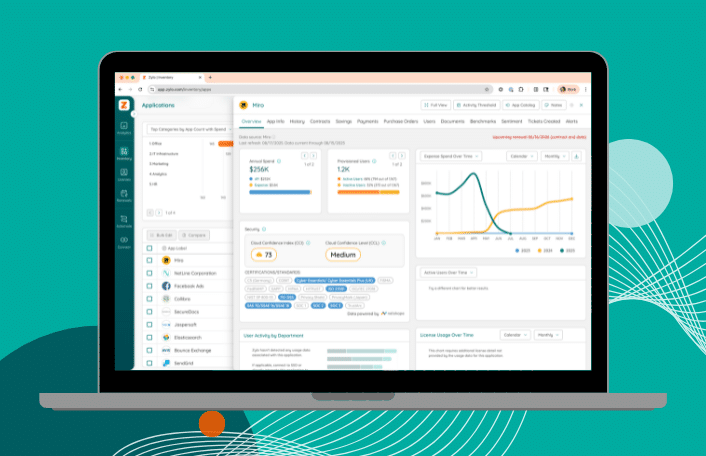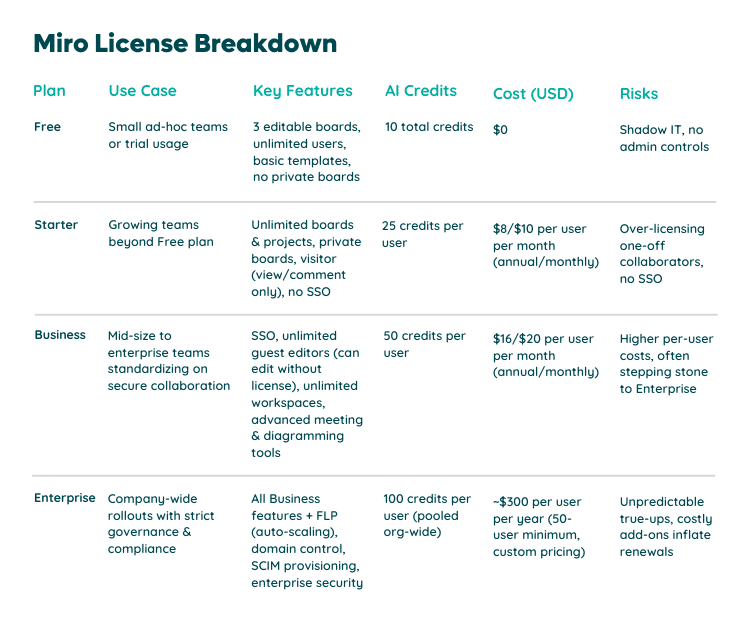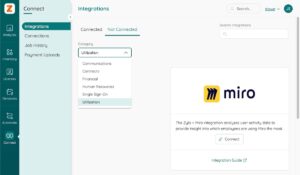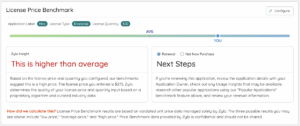
FinOps Software Explained: Benefits, Tools & Key Features
Table of Contents ToggleWhat FinOps Means in the Modern Cloud EnvironmentWhy...
Back
Back
Search for Keywords...
Blog

Table of Contents
Miro’s licensing model is engineered for overspend. Enterprises face shelfware, surprise license costs, and AI add-ons that quietly inflate spend. Today, Zylo data shows 61% of licenses go unused, and the average company spends $85K annually—with nearly $52K wasted.
 The impact is widespread. IT teams lose visibility as employees create unvetted instances. Software Asset Managers struggle to align spend with actual usage. Procurement misses leverage to negotiate fair terms. Without active Miro license management, costs expand quietly and relentlessly.
The impact is widespread. IT teams lose visibility as employees create unvetted instances. Software Asset Managers struggle to align spend with actual usage. Procurement misses leverage to negotiate fair terms. Without active Miro license management, costs expand quietly and relentlessly.
The challenge is real—but it’s also solvable. Enterprises that bring data, automation, and benchmarks to their Miro environment can reclaim wasted spend, reduce risk, and approach renewals with confidence.
In this article, I’ll cover:
Miro offers collaboration at scale, but its licensing tiers and add-ons are structured in ways that generate unpredictable spend. Understanding the traps built into its model is the first step toward controlling costs.
Miro’s tiered plans range from Free to Enterprise. Here’s how they break down:
Here’s a side-by-side comparison of Miro’s license tiers:

The problem? Feature requirements, not team size, often force upgrades. For example:
These price jumps add up fast—especially when admins provision “just in case.”
Guest access feels like a cost-saver, but without the right guardrails, it introduces both spend and risk.
The catch? IT loses control if guest access is unmanaged. Sensitive boards may be shared broadly, and rogue guests can create compliance risks. Many companies end up buying licenses for occasional collaborators out of caution, inflating costs unnecessarily.
Enterprise customers gain access to the Flexible Licensing Program (FLP). This model:
FLP license upgrades, which are never automatic, include:
While convenient, FLP makes it nearly impossible to predict license counts. Admins often discover ballooning usage at renewal with limited room to negotiate down. Without strict governance, FLP shifts cost control from proactive to reactive.
Miro AI features (summarization, diagramming, clustering) are metered by credits. Each plan includes monthly credits:
Once teams exceed their monthly credit limit, organizations must buy the Miro AI Add-On to increase it. This is only available for Starter, Business, and Enterprise plans, billed across all licensed users—even if only a few rely on AI.
AI Add-On cost:
This consumption-driven pricing mirrors broader SaaS trends: innovation is monetized incrementally, and IT leaders must track yet another variable to prevent overruns.
The IT Leader’s Guide to Software License Management
Learn MoreMiro’s pricing structure isn’t just about per-seat licenses. In my experience, the real financial impact comes from hidden and often unmonitored costs—costs that accumulate quietly until renewal. Look out for:
Zylo data shows that the majority of Miro licenses go unused, driving thousands of dollars of waste every year for a typical company.
Automated license reclamation and ongoing monitoring are the only reliable ways to eliminate this waste.
Departments and individuals frequently buy Miro Starter or Business plans on credit cards. With 83% SaaS purchasing decentralized across the business, IT and Procurement often have no visibility until spend appears on expense reports.
The risks:
This is a growing problem. IT loses control, SAM can’t validate usage, and Procurement misses enterprise pricing opportunities.
Enterprise Miro customers enrolled in the Flexible Licensing Program (FLP) face quarterly or annual true-ups. Seat counts expand automatically as new employees join, and there’s rarely an easy way to scale back mid-contract.
Every unmanaged license or guest creates security exposure. Gartner predicts organizations without centralized SaaS visibility are 5X more likely to experience a cyber incident or data loss. For IT leaders accountable for access controls, the cost of a breach dwarfs the license savings conversation.
The reason enterprises overlook these expenses is simple: lack of visibility and accountability. SaaS Management is spread across IT, SAM, and Procurement. Each sees part of the problem, but without a unified system of record, no one has the full picture.
The complexity of Miro’s licensing model doesn’t mean cost control is out of reach. Enterprises can reclaim wasted spend and reduce risk by focusing on practical, repeatable actions. I recommend these tactics for effective Miro license management and optimization:
Start with visibility into how employees use Miro. Miro’s admin dashboards provide visibility into activity, but it’s often just a partial view that does not include spend, owner, and other app-related data.
Steps to take:
This ensures every license is tied to genuine usage, not “just in case” provisioning.
Automating license reclamation reduces waste and saves time.
Steps to take:
By regularly reclaiming licenses, you close the loop and prevent idle licenses from piling up. This is especially important during FLP true-up periods. It’s easy for users to be silently auto-upgraded, hitting you with a larger-than-expected bill.
Guest access is one of the easiest ways to reduce license bloat, but only if managed correctly. Shadow IT subscriptions compound the challenge.
Steps to take:
Clear policies and enforcement prevent waste while maintaining collaboration flexibility.
While all Miro plans include AI credits, your spend can balloon quickly and unpredictably if you don’t monitor usage.
Steps to take:
This prevents small add-on charges from snowballing into enterprise-level costs.
The best time to capture savings is at renewal, but only if you walk in with facts, not vendor estimates.
Steps to take:
By treating renewals as a proactive process, Procurement and IT gain leverage to negotiate lower rates and right-size commitments.
ModMed Drives Operational Excellence & Million-Dollar Savings with Zylo SaaS License Management
Discover how ModMed used Zylo’s powerful license tracking and optimization to save millions of dollars, drive operational excellence, and improve the employee experience.
Miro’s renewal process is designed to maximize vendor revenue. For effective Miro cost management, enterprises need to approach renewals with the same discipline they bring to audits. Here’s a tactical playbook to follow:
Why it matters: A unified front avoids the common vendor tactic of bypassing one function to push approvals elsewhere.
Why it matters: Entering renewal conversations with accurate utilization data ensures you control the narrative—not the vendor.
Why it matters: Published pricing rarely reflects enterprise deals. Without benchmarks, you negotiate in the dark.
According to Miro’s website, “eligible non-profits will receive a 30% discount on any Miro plan. It may be combined with our standard annual discount (20%) on Starter and Business plans, which gives 44% off the purchase.”
Why it matters: FLP and rigid contracts create one-way cost escalations. Protecting flexibility prevents budget surprises.
Managing Miro licenses effectively requires more than spreadsheets or native admin dashboards. Zylo brings structure, automation, and intelligence to Miro license management through direct product capabilities that eliminate waste and simplify renewals.
Zylo offers a direct integration with Miro, giving IT, SAM, and Procurement leaders the visibility they can’t get from spreadsheets or static reports.
With Zylo’s Miro direct integration, IT and SAM leaders gain visibility into:
Outcome: A comprehensive, real-time view of Miro usage that uncovers waste, strengthens governance, and informs smarter renewal strategies.


With Zylo Workflows, the license reclamation becomes automated. Unused or inactive licenses are flagged and reclaimed, then recycled to new users instead of driving new purchases.
Outcome: Continuous reduction of shelfware without burdening IT with manual audits.
Zylo Insights transform raw usage data into clear, actionable recommendations. By analyzing Miro’s user activity, license types, and board sharing patterns, Zylo pinpoints exactly where cost and risk can be reduced.
With Insights, you can:
Outcome: Data-driven optimization and stronger governance, ensuring every Miro license delivers value and compliance.
Zylo transforms renewals from reactive events into proactive strategies. With usage data, cost benchmarks, and shelfware analysis in one place, Procurement teams enter vendor negotiations prepared.
Outcome: Stronger negotiation leverage, lower renewal counts, and reduced per-seat costs.

Miro isn’t going to make license management easy. Its model profits when enterprises overspend. Hidden shelfware, flexible licensing, and costly add-ons are built into the system. Without visibility and control, budgets quietly bleed while risk increases.
Enterprises that bring data, automation, and benchmarks to their Miro environment change the game. With Zylo’s direct integration, automated license reclamation, and renewal insights, organizations finally gain the leverage to cut waste and negotiate from a position of strength.
Stop paying for unused Miro licenses. Learn more about Zylo’s License Management solution and request a demo today to see how much you can save before your next renewal.
The FLP automatically assigns licenses as new users join, with costs reconciled at semi-annual true-ups. While this prevents collaboration bottlenecks, it makes budgets unpredictable. Enterprises often discover large license growth at renewal, with little room to scale back.
Yes, but only on Business and Enterprise plans, which allow unlimited guest editors to create and edit content without consuming a paid license. On the Starter plan, guests can only view or comment, meaning many organizations mistakenly assign full paid licenses to occasional collaborators.
AI credits reset monthly and vary by tier:
Once credits are used up, enterprises must purchase the AI Add-On, billed across all licensed users. This can add thousands of dollars annually, even if only a few teams actively use AI.
Zylo’s direct integration with Miro provides visibility into:
With this data, Zylo automates license reclamation, flags optimization opportunities, and equips Procurement with benchmarks for stronger renewals.
ABOUT THE AUTHOR

Connor Mullaney
Connor is a Product Manager at Zylo with a background in customer service, having supported the company’s largest Enterprise clients. In his role today, he helps drive Zylo’s product strategy for SaaS licensing, usage, and consumption/capacity tracking. Before Zylo, Connor worked as a Software Asset Management (SAM) consultant, helping Enterprises build effective licensing positions (ELP) and manage audits for major software publishers. With firsthand experience of how manual SAM and SaaS Management can be, he’s passionate about building solutions that surface meaningful insights and cost-saving opportunities for clients.

Table of Contents ToggleWhat FinOps Means in the Modern Cloud EnvironmentWhy...

Table of Contents ToggleHow Miro’s Licensing Model Creates Complexity (and Cost)Free,...

Table of Contents ToggleHow Miro’s Licensing Model Creates Complexity (and Cost)Free,...

Table of Contents ToggleKey Themes That Shaped SaaS Management in 20251....
| Cookie | Duration | Description |
|---|---|---|
| cookielawinfo-checkbox-analytics | 11 months | This cookie is set by GDPR Cookie Consent plugin. The cookie is used to store the user consent for the cookies in the category "Analytics". |
| cookielawinfo-checkbox-functional | 11 months | The cookie is set by GDPR cookie consent to record the user consent for the cookies in the category "Functional". |
| cookielawinfo-checkbox-necessary | 11 months | This cookie is set by GDPR Cookie Consent plugin. The cookies is used to store the user consent for the cookies in the category "Necessary". |
| cookielawinfo-checkbox-others | 11 months | This cookie is set by GDPR Cookie Consent plugin. The cookie is used to store the user consent for the cookies in the category "Other. |
| cookielawinfo-checkbox-performance | 11 months | This cookie is set by GDPR Cookie Consent plugin. The cookie is used to store the user consent for the cookies in the category "Performance". |
| viewed_cookie_policy | 11 months | The cookie is set by the GDPR Cookie Consent plugin and is used to store whether or not user has consented to the use of cookies. It does not store any personal data. |
